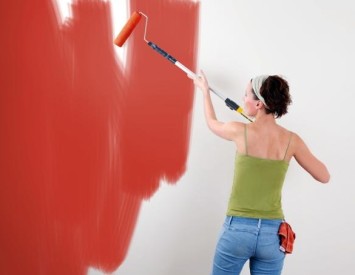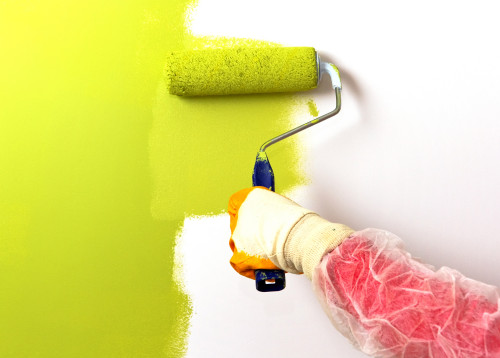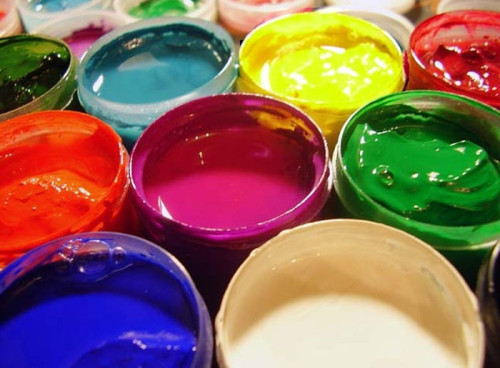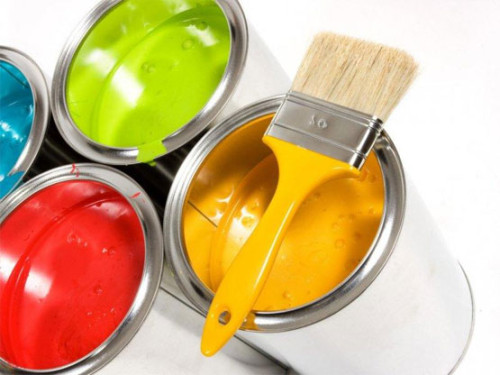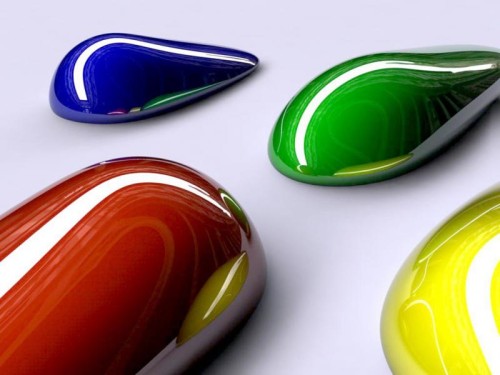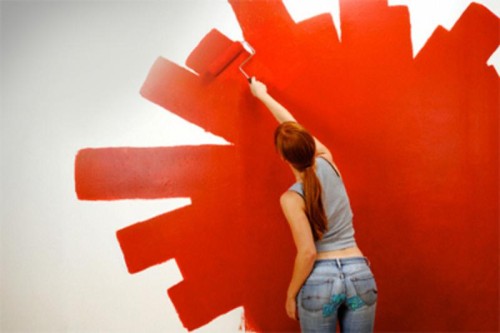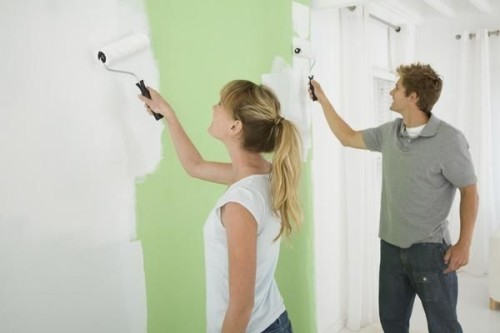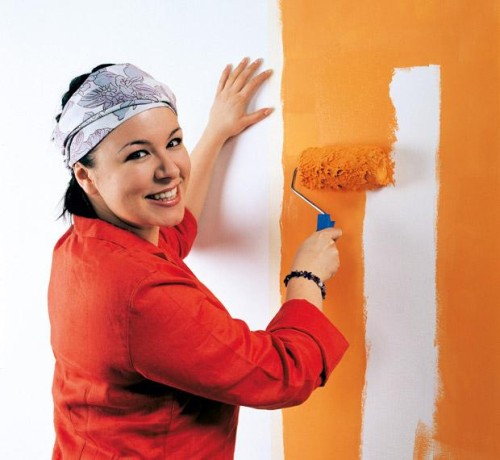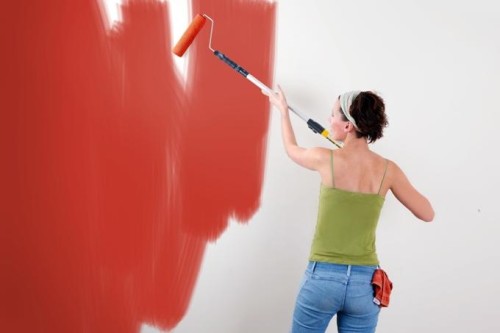The decoration of the walls of the apartment is the most important stage in the entire repair, as it completes the entire cycle of work. There can be many options for wall cladding and each of them has its own advantages and disadvantages, so the choice in favor of any way must be made based on the specific situation and the desire of the owner of the room.
Content
Advantages and disadvantages of painting
Wall painting has recently gained popularity. This option of wall decoration has a large number of advantages. Compared to unattractive painted panels of half the walls that were found in Soviet high -rise buildings, modern materials can create a unique interior. And the variety of shades will make it interesting. The painted walls can be easily updated at any time, without spending a lot of efforts and funds. Just a couple of cans of water -based paint, a little time and the interior of the room can be changed beyond recognition. The painted walls are fireproof in comparison with the wallpaper, not subject to mechanical damage, and retain a presentable look for a long time.
Of the shortcomings of the walls painted with paint, one can distinguish that they need to be prepared. The surface that is planned to be painted should be perfectly flat, without flaws. Otherwise, the painting will only ruin everything
The choice of optimal paint for repair work in the room is a rather difficult task. And if there is usually no problem with color (modern devices for coloring can create any shade), then with the type of paint for a person who has not encountered such a task, problems may arise. About which paint is better to choose for painting the walls, we will talk further.
Water -based wall paint
The name of these types of colors speaks for itself. Their solvent is ordinary water. Such mixtures are the most popular when painting walls for several reasons:
- Relatively low price. The cost of water -based paints, in comparison with alkyd, is not too high, which favorably affects the overall costs for repairs. Moreover, such a paint has a small consumption of 1 m 2 surfaces. Since simple water is a solvent in water -based paints, even the stored paint can be easily and quickly diluted with water, which costs much cheaper than the solvent.
- Environmental friendliness. In the process, water -dispersed paints do not emit harmful vapors, like alkyd. In the renovated room you can have a large amount of time without much harm to well -being.
- Pollution resistance. Any spot of dirt, due to the fact that it cannot penetrate inside the painted surface, can be easily washed off with water.
Among the shortcomings of the paint itself, one can distinguish that it is very afraid of negative temperatures. If the container with paint stands in the cold, it will not be used in the future.
Water -based paints are divided into:
- Based on PVA.
- Acrylic.
- Latex.
Polyvinyl acetate water -based water -based paints are their cheapest variety. Of all types, such material does not differ in practicality, since it is easily subject to pollution. They are used mainly for painting ceilings. The great advantage of such colors is that they have good vapor permeability, so that the surface can “breathe”. PVA -based paint cannot be used in rooms with high humidity.
The basis for acrylic paints for walls are acrylic resins. Thanks to them, the structure of the material becomes dense and does not pass dirt and moisture. Therefore, they are often used for painting walls in public places where the probability of pollution is quite high. Also, due to the dense layer that quickly dries, the paint does not pass moisture to the wall, which makes it possible to use it in places with high humidity, for example, for decoration of the walls of the bathrooms. It dries quite quickly and does not emit absolutely any smell.
The disadvantage of such paint is that it has low vapor permeability, that is, it does not allow the walls to “breathe”.
Latex paints are made on the basis of a well -known polymer. The thin layer of latex allows to improve the mechanical resistance of the surface to moisture and dirt, which allows you to successfully use them in public places. Like acrylic, latex paint dries quite quickly, lies in a thin and dense layer. It is often used when painting textured wallpaper when it is necessary to highlight their drawing. Such paint is very suitable for Venetian plaster or “bark beetle”, because it can penetrate deep into the structure of the coating, while laying down with a thin layer. Based on latex, special paints for walls with an effect are made.
Like acrylic paints, latex do not “breathe”, which repels many from their purchase.
Alkyd paints
Alkyd paints, or, as they are also called, enamel, differ from water -based in that hydrocarbon substances are used as a solvent: gasoline, kerosene, solvent, etc. The structure of the paint itself is similar to the latex water -dispersed, however, the process of its drying occurs not due to the evaporation of water, but due to the oxidative reaction with the participation of oxygen in the air. Thanks to this, alkyd paints dry very quickly.
The main advantage of such colors is their durability, excellent surface protection from moisture, mechanical damage. Due to the fact that when applying, such a paint forms a thin but rather strong layer, in addition to processing walls, they are used to process wooden and metal surfaces, protecting them from rust.
The disadvantage of enamels is a pungent smell that does not quite well affect the human body. Therefore, after the end of the work, the room must be carefully ventilated and restricted in it. Although enamel has recently appeared, the solvents of which do not emit a pungent odor, use them in the room for painting the surfaces of a large area must be carefully.
Oil paints
A feature of oil paints is that natural or synthetic oils, as well as olifs, are used as their solvents. This feature is the reason that such paints dry for a very long time, while highlighting a not very pleasant smell. It is because of this that oil mixtures for processing the internal walls of the room are extremely rare. The advantage of oil paint is its excellent antiseptic properties. Olifa and oils are able to penetrate deep into the pores of plaster or wood, protecting them from the appearance of fungus or mold. However, this feature has another side of the coin. So, reduced vapor permeability can cause plaster exfoliation.
The layer of such material applied to the surface can last a single year without repainting. Thanks to this, oil paints are often used for external work.
Silicone paint for walls and ceilings
This is new material in the construction industry. Thanks to the use of various additives in its production, it has excellent operational properties. Vapor permeability, moisture resistance and wear resistance - the buyer will find all these qualities in silicone paint. Its main advantage is considered to be not wetted by water, which is formed when applied. It is it that allows the surface for a long time to have a original appearance, even in places of high humidity.
The disadvantage of such paint can be considered its price. It is slightly higher than that of a latex -based water -based mixture.
Eco-paints for walls
Fashion for the use of environmentally friendly materials in construction work increased the demand for such products. The technology for manufacturing eco-paints involves the use of natural components in their composition that are not harmful to the human body. That is why they can be used without any fears for painting walls in an apartment or house.
The disadvantage of such colors, of course, is their price, which is why they are trying to use them in a limited number of cases, for example, for painting a children's room. It is also worth noting that eco-paints dry quite slowly, but at the same time, without highlighting any smells.
Applying water -based paint on the walls
Work order:
- Water -based paint is applied to the surface of the wall with a roller with a long pile. Before starting work, the preparation of both material and surface is carried out.
- The surface of the wall aligned by putty is necessary before painting it is necessary to disagree. This is done by a mixture of deep penetration based on PVA. During the primer, the wall is checked for the presence of minor defects that must be removed.
- At that time, while the primer will dry, the preparation of paint is carried out. It must be thoroughly mixed until a homogeneous mass. Experts recommend doing this on the eve of work (about a day) and immediately before starting. For uniform stirring, a low -speed drill with a special nozzle in the form of a mixer is used. If desired, before starting work, you can change the color of the paint for the walls. To do this, use special collars. However, they should be neat, because without guessing a consistency a little, you can not get the necessary color. If the shade of the walls plays great importance, it is better to make it in specialized stores that have special equipment that clearly doses the chip, depending on the selected palette.
- Prepared paint is poured into a special trough and lowered into it. After that, it is rolled out so that the mixture is distributed over its entire surface. The textured paint for the walls is applied with a special roller.
- Apply paint to the wall, gradually rolling out, until there is a homogeneous pattern without stains on the surface.
When painting walls with water -based paint, it is better not to apply more than one layer.
